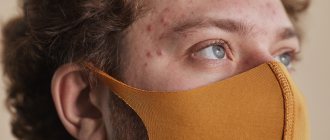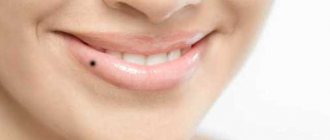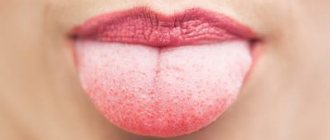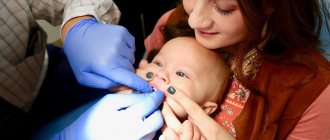- What kind of disease is candidiasis?
- Symptoms
- Causes
- Treatment
- Therapy methods
- Preventive measures
Many parents are aware of such a common problem in children as thrush, which is characterized by the appearance of a white coating on the tissues of the oral cavity. In medicine, this pathological condition is called “candidiasis” and refers to fungal diseases. Candidiasis most often develops in a child’s mouth in the first year of life. The symptoms of thrush are very disturbing for the baby, but timely treatment allows you to get rid of the fungus quickly and without consequences.
What kind of disease is candidiasis?
According to statistics, about 30% of infants experience candidiasis. The causative agent of the disease is Candida fungus. These specific microorganisms are normally present in the body of every person, even in the absence of health problems, but only in small quantities.
Oral candidiasis in children is much more common, since the immune system of children is not yet formed and is not able to resist pathogenic microorganisms and the effects of negative external factors.
With weakened immunity and the concomitant influence of provoking factors, the fungus begins to actively multiply, affecting the mucous membranes. Without therapeutic treatment, candidiasis is eliminated in exceptional cases. Much more often, if thrush is not treated, complications arise, and the infection itself spreads throughout the body.
Causes of thrush
What are the causes of this disease? Often, a child becomes infected from the mother during childbirth, or if the mother neglects intimate hygiene. Therefore, a pregnant woman diagnosed with bacterial candidiasis needs to be observed by specialists. Infection through toys and pacifiers is possible in the absence of sanitary treatment. Thrush can occur in children while taking antibiotics, allergies, a tendency to regurgitate, or frequent colds. These facts indicate that the pathogenic fungus lives in almost every person, but becomes pathogenic only with a decrease in immunity and in the presence of a suitable environment (lactic acid).
Mothers need to know that a baby who receives breast milk is less likely to encounter thrush problems. But, nevertheless, an important factor in protecting against infection is the observance of simple hygiene rules, this becomes especially important as the baby grows up, when all objects that fall into his hands immediately end up in his mouth.
Symptoms
Oral candidiasis in children can have different forms of manifestation and severity of symptoms: mild, moderate and severe. As a rule, each form corresponds to the stage of development of the disease. If therapy is not carried out in a timely manner, the signs of fungal infection become more intense and the number of symptoms increases.
In mild forms of the disease, a red rash appears on the oral mucosa, which is covered with a white coating on top. At the next stage, the child experiences swelling of the tissues and the formation of localized white spots with a coating of curd consistency. Gradually these spots merge into a larger affected area. When plaque is removed, bleeding ulcers open. If thrush starts, the fungus spreads to the entire oral cavity, including the lips, tongue and throat. All fabrics are completely covered with a curd coating.
Common symptoms of candidiasis in children include:
- burning and itching sensation in the mouth;
- discomfort and pain when eating;
- frequent regurgitation in babies;
- formation of cracks in the corners of the lips;
- temperature increase.
Children in the first two years of life report their condition by refusing to eat, constant whims and crying for no reason. It is not difficult to see the signs of candidiasis, so if a child has a sharp rise in temperature or refuses to eat, pediatricians and dentists recommend checking the oral cavity for the presence of white plaque. If you suspect thrush, it is not advisable to delay a visit to a specialist, since the fungal infection progresses quickly.
Komarovsky: thrush in a child’s mouth, symptoms
The famous pediatrician Evgeny Komarovsky constantly shares useful information about various diseases, their prevention, treatment, etc. Naturally, the doctor could not forget about thrush. He says that in addition to external and internal factors, saliva is to blame for the development of oral thrush. The fact is that it dries out, thereby reducing its protective properties. Saliva contains beneficial bacteria that prevent the growth of fungal agents in the mouth. When the quantitative indicator decreases and saliva is not able to fight microbes, opportunistic microorganisms begin to develop, causing thrush.
The mild stage of the disease is recognized by cheesy formations in the form of separately located plaques on the tongue, cheeks (inner side). In most cases, the disease does not bother the baby very much, and the temperature does not rise. If you detect white plaque in a timely manner, getting rid of it will be quite simple. To remove stains, use either a cotton swab or a sterile bandage, which is wrapped around one or two fingers. In mild cases, the gums become slightly swollen and red, and the oral mucosa becomes dry and smooth.
If there is no treatment, the disease manifests itself in moderate severity. Then the areas affected by fungi appear as formations in the form of yellow films. The infection also spreads to the baby's lips. The plaque must be removed very carefully, and it is better to entrust the procedure to doctors, since wounds remain under the tubercles, causing pain. Typically, a sick child has a low-grade fever, an irritable state, he is nervous and capricious. Often babies refuse to eat or suck on bottles of milk.
A severe form of thrush has an extremely negative effect on the entire oral mucosa. Individual cheesy islands combine to form a single film that covers the cheeks and tongue, gums, walls of the pharynx and lips. It is prohibited to remove it, since the procedure is very complicated and causes pain. If you try to remove the plaque, bleeding erosions and wounds will remain underneath it, so it is better not to touch them. The child is in a state of malaise due to high fever and pain in the mouth. Therapeutic therapy takes a long time and includes various treatment methods (local, general). For infants, this stage of thrush presents a difficult challenge.
Causes
The main reason for the development of candidiasis of the oral mucosa in children is weakened immunity. If a baby is born premature, the likelihood of developing thrush is very high. Children who are breastfed or have congenital pathologies are also often exposed to fungal infections.
Provoking factors include:
- the presence of vaginal candidiasis in the mother during pregnancy (the child can become infected when passing through the birth canal);
- insufficient hygiene of the female breast during breastfeeding (the fungus is often localized specifically on the nipples due to the environment favorable for it);
- poor handling of the child’s initial things (bottles, pacifiers, etc.);
- parents’ habit of licking nipples (even if the adult has no signs of thrush, there may be a fungus in the mouth that can be passed on to the child);
- long-term use of drugs from the “antibiotics” group (medicines help reduce one’s own immunity);
- frequent regurgitation in infants (after regurgitation, an increased acidic environment will remain inside the oral cavity, favorable for fungus);
- excessive and frequent dry mouth (lack of saliva as a protective agent against the activity of pathological microorganisms).
Infection with Candida fungus in children over 2 years of age can occur as a result of consuming unwashed foods, raw milk or running water. If a child over 3 years of age suddenly shows signs of thrush, they should be examined not only for a fungal infection, but also for other possible diseases that may be accompanied by a “decay” of the immune system.
Treatment of thrush in children
The development of oral thrush in children is one of the disorders in the child’s body that does not need to be treated with special antifungal agents. The main thing in this process is to provide the child with a comfortable microclimate with moist and cool air. It is also necessary to ensure that the child breathes through the nose, since the mucous membranes dry out quickly when breathing through the mouth. This leads to cracks and wounds, which promote the proliferation of fungi.
It is important that the child breathes through the nose
Let us list the basic conditions necessary for the body to fight thrush:
- normal microclimate in the room;
- free nasal breathing;
- strong immunity.
It is worth strengthening the immunity of the baby and schoolchildren
Important! If all three points are followed, the white plaque should go away without any help. Usually, the child’s immunity is not yet fully developed. Therefore, there is a need to help him cope with the disease.
Soda and honey solutions in the treatment of thrush
The appearance of white plaque in a child’s mouth requires immediate action to eliminate it. One of these emergency actions is to moisten the child’s oral mucous membranes with a soda solution. Method of its preparation: one teaspoon of soda is poured into warm water (0.2 l) and stirred until dissolved. Using a bandage, you need to treat the affected areas of the mouth with this solution. It is important to wet it, and not to rub or remove the white coating. Such actions can damage the surface of the shell and thereby allow harmful microorganisms to enter the child’s body.
Important! Such procedures must be done up to five times a day.
Use soda solution
The same procedure can be carried out using a honey solution. The method of preparing it is as follows: dissolve one teaspoon of honey in two teaspoons of warm water. Water for preparing solutions is always boiled. The honey solution tastes good, so the child agrees more easily to this procedure. Of course, the use of honey requires caution, because it can cause allergies in the baby.
Important! All procedures using this solution are performed every two to three hours.
Honey solution is also used for treatment.
Sometimes it is very difficult to force a small child to open his mouth for therapeutic procedures. There is a proven method: press your thumb on his chin and hold in this position until the procedure is completed.
The use of medications to treat thrush
For advanced disease in newborns, traditional drug treatments are used. They are used when there is a risk of candidiasis affecting a larger part of the child’s body. If fungi multiply in the intestines, this will disrupt its natural microflora and thereby harm the body and reduce immunity.
- Frequent urination or why do I pee so often?
Important! If the fungus moves to the genitals of girls, vulvovaginitis and synechia may develop, which are difficult to treat or lead to the need for surgical intervention.
Vulvovaginitis
Doctors advise not to expect complications to appear, but to begin treatment immediately with medical means. Treatment of infants begins with checking the mother for thrush, since unilateral treatment in this case will not have a positive effect. The doctor will prescribe the necessary treatment for the baby's mother.
It is better to start treatment after the first symptoms appear
Important! The appearance of signs of thrush in a newborn baby requires immediate examination by a pediatrician. Depending on the degree of the disease, the doctor prescribes appropriate treatment.
- The initial stages of thrush in a child's mouth are usually treated with special aqueous suspensions to treat the white plaque. For example, a Nystatin suspension is suitable, which you can purchase at a pharmacy or make yourself. The recipe for its preparation: one tablet is ground into powder and diluted in a small amount of water. Plaque in the mouth should be treated with this product every five hours.
"Nystatin"
- Plaque can be cleaned with a soda solution, the preparation recipe for which is described above, or with a one percent solution of hydrogen peroxide.
- To wash the affected areas, a one percent solution of clotrimazole or the drug “Candide” can be used. These products can be used to treat the mucous membranes of the mouth two or three times a day.
"Clotrimazole"
- If external rinsing with medicinal agents does not produce results, this means that the child has a more severe form of candidiasis and is the basis for the use of antibiotics. In such cases, the doctor prescribes antifungal drugs for oral administration.
With effective and timely treatment, the white plaque from thrush disappears quickly. The maximum treatment period for the disease is 10 days. The older the child gets, the less often relapses of this disease are observed. This is explained by the formation of stable immunity to this genus of microorganisms.
If treatment is started on time, the white plaque in the mouth will quickly disappear
Treatment
Fungal diseases in children can be treated by a pediatrician, an infectious disease specialist or a dermatologist. If we are talking about the treatment of oral thrush, then therapy can also be carried out by a dentist.
The diagnosis of candidiasis is determined in most cases based on an examination of the oral cavity performed by a specialist. If there is any doubt, the doctor refers the patient for additional examinations. More often, to confirm the disease, a laboratory test is used to test a smear taken from the mouth for the presence of fungus.
Treatment of thrush in children requires an integrated approach. If the disease is not advanced, then local therapy is carried out in combination with measures to strengthen the immune system. In severe cases, oral candidiasis in children is treated with systemic drugs, local agents and compliance with preventive recommendations.
Treatment of thrush in young children under one year of age
The appearance of a mild form of oral thrush in children under one year of age is usually treated without the use of medications. It is only necessary to provide the baby with the right living conditions.
- Maintaining cleanliness in the room where the baby is, regular wet cleaning, washing the toys he uses, boiling pacifiers, feeding bottles and pacifiers are essential.
Parents should carry out wet cleaning regularly
- The ideal microclimate in the room where the baby is: air temperature no higher than 20 degrees Celsius, sufficient humidity, but not more than 60%. Excessive dampness in the room allows various bacteria and mold to develop. Mold can lead to various diseases.
- Constantly moisturize the child’s oral mucosa with special means. It is important to ensure that your baby breathes through his nose. A stuffy nose causes the child to constantly breathe through the mouth.
It is worth moisturizing the baby's oral mucosa
For more severe forms of thrush, medications are used even for the smallest children. The doctor may prescribe antifungal and antiseptic solutions for local therapy. There is an effective remedy for washing affected areas in the mouth, which can be easily prepared at home: mix 10 ml of pharmaceutical hydrogen peroxide, 12 g of baking soda in 1 liter of boiled water. Soak your finger wrapped in a bandage in this solution and treat your gums and tongue.
You can treat your baby's mouth with a bandage.
Therapy methods
Treatment of candidiasis begins with treatment of the oral cavity. The first procedure is performed by a specialist at the appointment. Antiseptic agents are used to remove plaque. The doctor may then apply an antifungal agent.
The parent should closely monitor the dentist’s actions, since in the future they will have to treat the oral cavity themselves at home. The necessary medications will be prescribed by a specialist. Local antifungal agents are dangerous in case of overdose, especially for children, so you must strictly follow your doctor’s recommendations.
In advanced cases, medications are prescribed in the form of solutions, drops or tablets. There are few drugs available to treat candidiasis in children. Replacing them with adult counterparts is also dangerous. The dosage must be strictly observed.
A mandatory addition to the main therapy is maintaining good hygiene, good sleep, proper nutrition and taking measures to strengthen the immune system (eating healthy foods, taking pharmaceutical vitamins if necessary, walking, etc.).
Prevention of thrush in children
Preventive measures for the occurrence of candidiasis in children.
- In case of general or infectious diseases of the child, monitor the condition of the oral mucosa so as not to miss the appearance of thrush at the initial stage.
- Use antibiotics only when necessary. They are prescribed after conducting a general blood test of the child and obtaining the appropriate results. During the use of antibacterial drugs, fluconazole is prescribed. Its use is associated with disease prevention. The dose is prescribed by the doctor depending on the child’s body weight and the degree of risk of developing thrush.
Antibiotics should not be used unless prescribed by a doctor
- Timely detection of thrush in the mother of the child and application of appropriate treatment. Observation should be carried out from pregnancy and during breastfeeding.
- Screening for the presence of thrush in newborns who are at risk. These include children born during complicated labor, premature babies and those with any developmental abnormalities. This also includes children with birth injuries of the central nervous system, respiratory disorders, and encephalopathies. If the child’s mother is diagnosed with thrush and has chronic gynecological diseases, her child is also subject to mandatory examination for the presence of Candidiasis fungus. Such an examination is carried out in the first seven days of a child’s life using microscopic and bacteriological methods. If results indicate the presence of candidiasis, treatment with antifungal drugs is used. In addition to these examinations, stool samples are periodically analyzed for dysbacteriosis.
You need to check your baby regularly
Candidiasis is a very common disease in early childhood. But if you adhere to all preventive measures, it is quite possible not to encounter it.
Manifestation of thrush
On the child's genitals
This type of thrush is not as common as in the mouth, but can still develop in a child. Obvious signs are redness and swelling of the genitals, burning and itching. In boys, inflammation of the foreskin, head of the penis, and scrotum is noted. In girls, the vagina and vulva are affected. Discharge from the genitals has a consistency reminiscent of cream or cottage cheese. The smell is either absent or similar to sour fermented milk product. If the disease was diagnosed on time, local treatment - ointments, creams, vaginal suppositories and tablets for girls - will be sufficient. If the symptoms were ignored, the treatment will take longer. Often, in addition to topical medications, systemic antimycotic drugs and drugs that strengthen the immune system are used.
On the skin
If Candida fungi have attacked the skin, most often they will choose areas that rot quickly and easily as a cozy and comfortable place: intergluteal folds, folds in the groin area, armpits. Sometimes the infection spreads to the back, skin of the arms, legs, and neck. The disease manifests itself in the form of painful wet spots that are red in color or small blisters. After a certain period of time, the bubbles burst, the affected areas unite and form fairly large areas. You can also recognize thrush in a child due to the following manifestations:
- clearly visible limitation of healthy skin and erosive areas of crimson color;
- the presence of a white coating on the rash;
- damp and even varnished surfaces of areas affected by candida.
In infants, the skin in the anal area most often suffers, since it is very sensitive and delicate. For the purpose of prevention, all pediatricians and Dr. Komarovsky recommend leaving the child without a diaper in order to avoid the formation of suitable conditions for the life of fungal agents. In addition to the skin, yeast fungi can establish and organize colonies on the nails. This type of such a popular disease begins to develop due to high humidity and local injuries. The infection can be noticed due to swelling and hyperemia in the places where candida penetrates the nail plate. With candidiasis, a change in the structure of the nail occurs: it becomes duller, thicker, and brown grooves are formed on top, located transversely. It is worth noting that there is no purulent discharge.
Thrush in the corners of the mouth
This form of the disease often occurs due to the spread of yeast from the child's mouth. Sometimes it develops as an independent disease, then the main cause is a lack of vitamin substances, in particular vitamin B2, which is called riboflavin. It is easy to recognize the infection: the skin in the corners of the mouth cracks, peels, becomes dry, and takes on a reddish color. (It happens that nearby areas serve as localization sites). Candidiasis is the second name of the disease. It often bothers young children. It is quite rare in adults. If it occurs, it occurs in females with a weak immune system.
What is candidal cheilitis?
People are willing to ask about this form of the disease on forums on the Internet. Dr. Komarovsky answers all user questions, including this one. Cheilitis is also called cheilosis. The infection is reflected in the form of inflammation of the mucous glands of the lips, a red border that can peel off and be swollen. Unpleasant characteristic symptoms are thinning of the skin, the presence of pus, burning sensations, yellow scales, the edges of which are raised. The causes of the disease are chemical damage, injuries, bad habits, allergic reactions to cosmetics. Parents, do not treat your child’s thrush on your own!
If you find any suspicious symptoms, take him to the hospital immediately. The doctor will examine you with his experienced eye, prescribe an examination, and then draw up a detailed individual treatment plan. All treatment recommendations listed in the article are provided for informational purposes only. If you have questions, ask our specialist! Let's fight fungi together!











